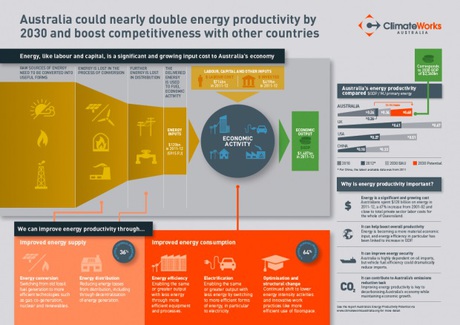Australia's energy productivity could double by 2030: report

Australia could almost double its energy productivity by 2030, delivering significant benefits to the economy, savings for businesses and a substantial reduction in greenhouse gas emissions, according to a new report released from ClimateWorks.
The ‘Australia’s Energy Productivity Potential’ report shows that much of this potential can come from energy-efficiency activities in our homes, offices, vehicles and industries, and by using technologies that are already available or in development.
“The report found Australia could increase its economic output from 24.3 cents of GDP in 2010 to 47.9 cents of GDP in 2030 - a 97% improvement,” said Anna Skarbek, executive director at ClimateWorks Australia.
“This includes simple measures like using LED lighting and more efficient heating and cooling systems to the automation of some industrial processes, and improving energy data systems.”
Skarbek said improvements by a further 36% can be made by switching from old fossil fuel generation to more efficient technologies, such as gas co-generation and renewables, and reducing energy losses that occur through the energy distribution process.
Switching to electricity in the transport and industry sectors, which would see more electric vehicles and conveyors to move materials, was another efficiency highlighted.
ClimateWorks Australia Head of Research Amandine Denis added that increasing energy productivity could improve Australia’s competitiveness and deliver substantial benefits to households and businesses hit by rising energy costs.
“In 2011-12, Australians spent $120 billion on energy across the economy, which is equivalent to 8.2% of Australia’s GDP in that year,” she said.
“Energy productivity improvements, particularly through the implementation of many profitable energy-efficiency opportunities, can help reduce expenditure on energy, or ensure that there is a greater economic return for every dollar spent on energy.
“The report shows the technology is available for Australia to modernise its energy system and dramatically increase its energy productivity by 2030.”
Companies such as Simplot Australia are showing that ambitious improvements in energy productivity are achievable. Simplot’s 2014 Sustainability Report revealed it has already reduced energy consumption per tonne of production by 12% compared to 2008 levels, and is targeting a 25% improvement by 2018.
View the full report at: http://www.climateworksaustralia.org/.
2025 saw record EV sales in Australia
More than 157,000 electric vehicles were sold in the nation last year, accounting for 13% of all...
2025–26 GenCost report released for public consultation
Solar PV and onshore wind still form the basis for Australia's cheapest electricity...
ARENA invests $21m in three EV charging projects
Funded under the Driving the Nation Program, the projects will focus on developing pathways and...



